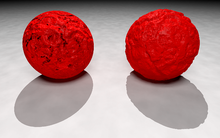File:Bump map vs isosurface2.png
Vai alla navigazione
Vai alla ricerca

Dimensioni di questa anteprima: 800 × 500 pixel. Altre risoluzioni: 320 × 200 pixel | 640 × 400 pixel | 1 024 × 640 pixel | 1 280 × 800 pixel | 1 680 × 1 050 pixel.
File originale (1 680 × 1 050 pixel, dimensione del file: 1,19 MB, tipo MIME: image/png)
Cronologia del file
Fare clic su un gruppo data/ora per vedere il file come si presentava nel momento indicato.
| Data/Ora | Miniatura | Dimensioni | Utente | Commento | |
|---|---|---|---|---|---|
| attuale | 12:41, 22 ott 2010 |  | 1 680 × 1 050 (1,19 MB) | GDallimore | {{Information |Description={{en|1=== Summary == {{Created with Persistence of Vision}} {{Information |Description={{en|1=Raytraced image illustrating the limitations of w:bump mapping created with w:POV-Ray. The bumpy surface of the sphere to th |
Pagine che usano questo file
La seguente pagina usa questo file:
Utilizzo globale del file
Anche i seguenti wiki usano questo file:
- Usato nelle seguenti pagine di ckb.wikipedia.org:
- Usato nelle seguenti pagine di de.wikipedia.org:
- Usato nelle seguenti pagine di en.wikipedia.org:
- Usato nelle seguenti pagine di fr.wikipedia.org:
- Usato nelle seguenti pagine di hu.wikipedia.org:
- Usato nelle seguenti pagine di ja.wikipedia.org:
- Usato nelle seguenti pagine di ko.wikipedia.org:
- Usato nelle seguenti pagine di lv.wikipedia.org:
- Usato nelle seguenti pagine di pt.wikipedia.org:
- Usato nelle seguenti pagine di ru.wikipedia.org:
- Usato nelle seguenti pagine di uk.wikipedia.org:
- Usato nelle seguenti pagine di zh.wikipedia.org:

